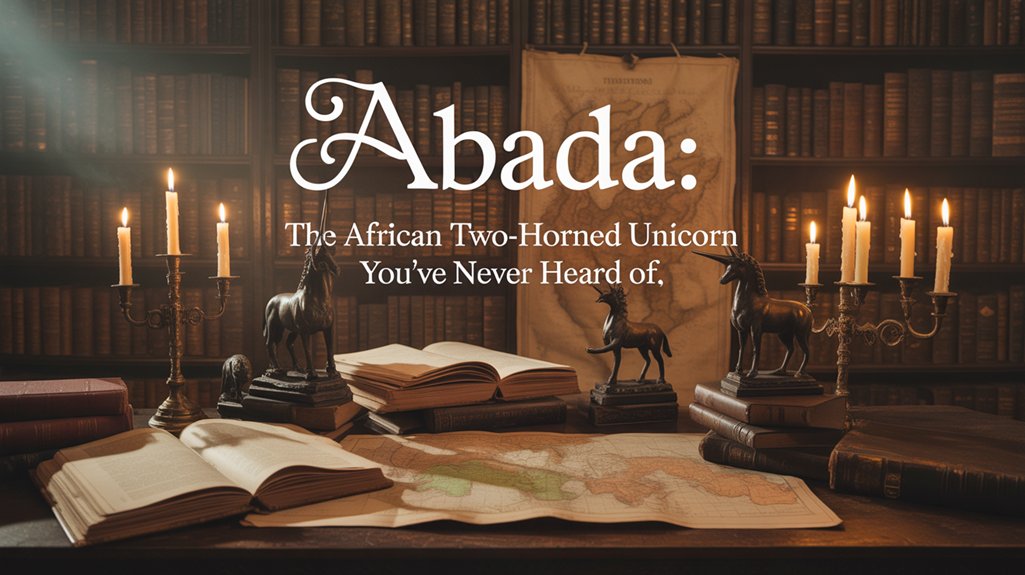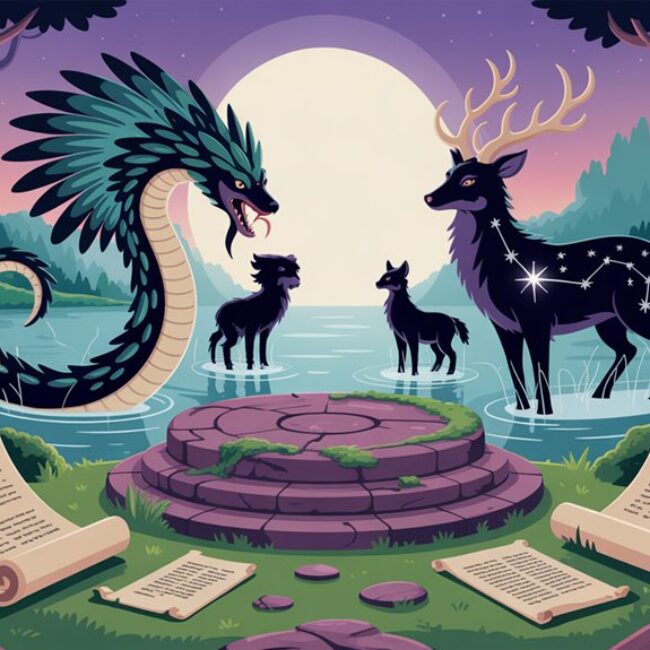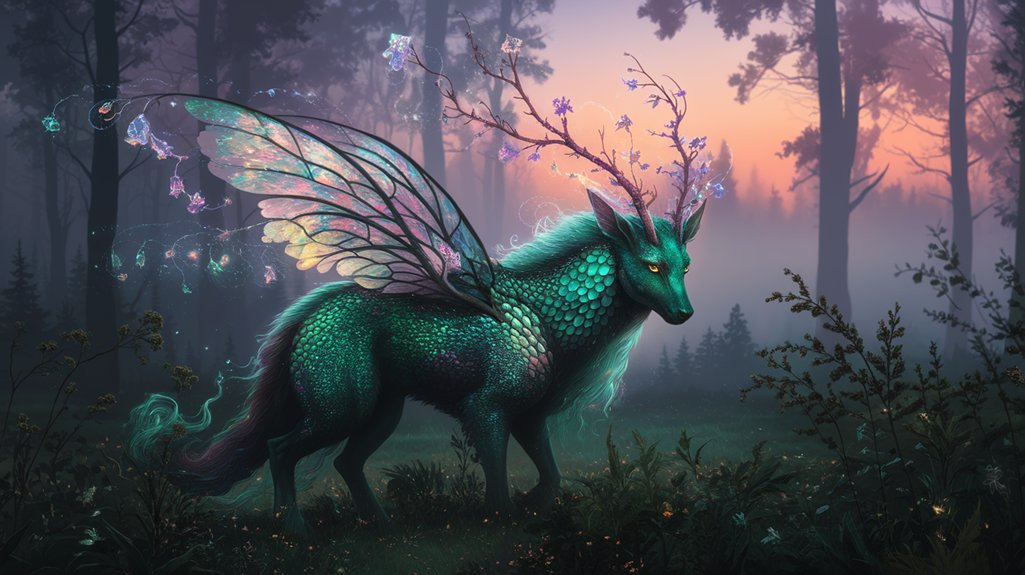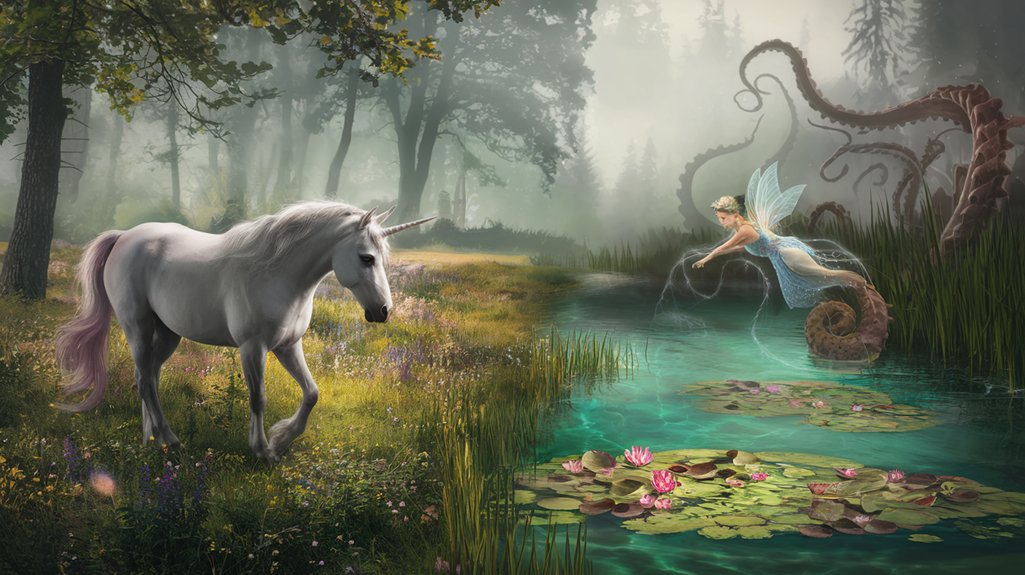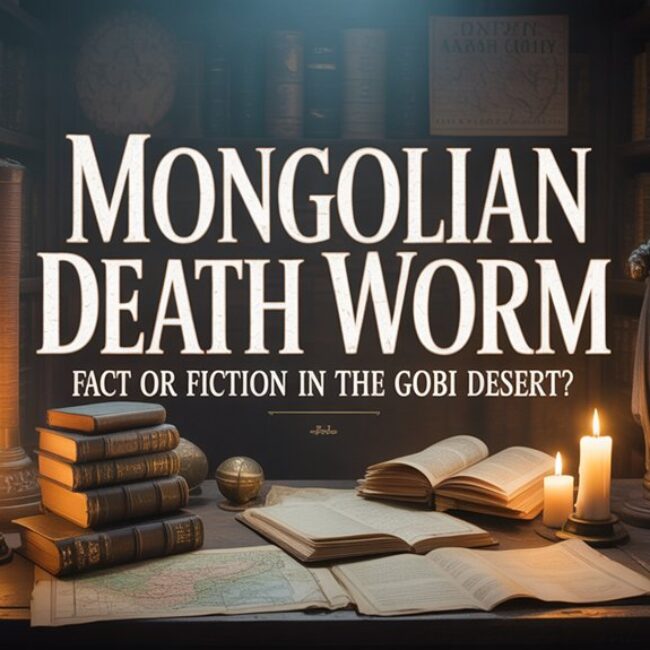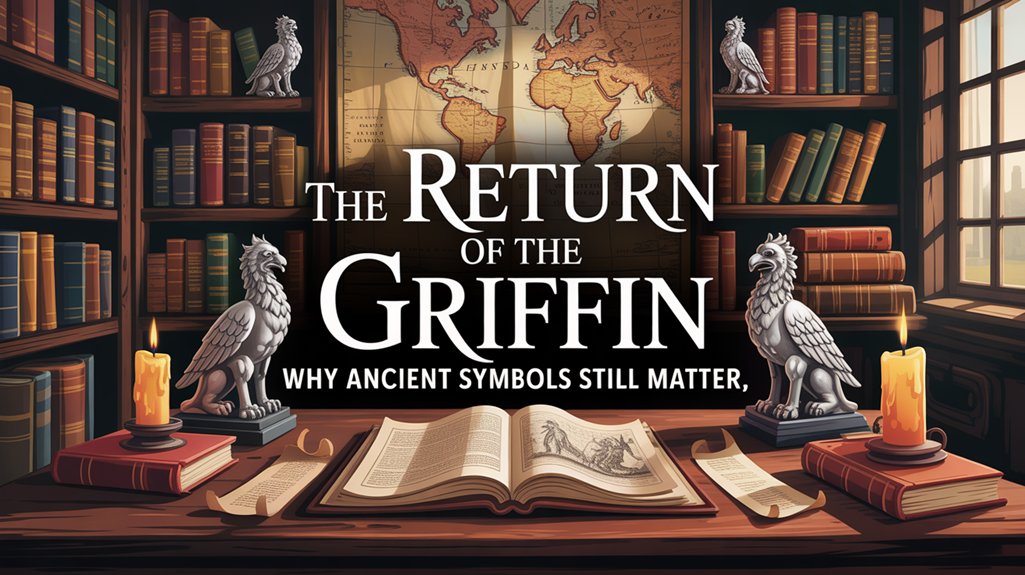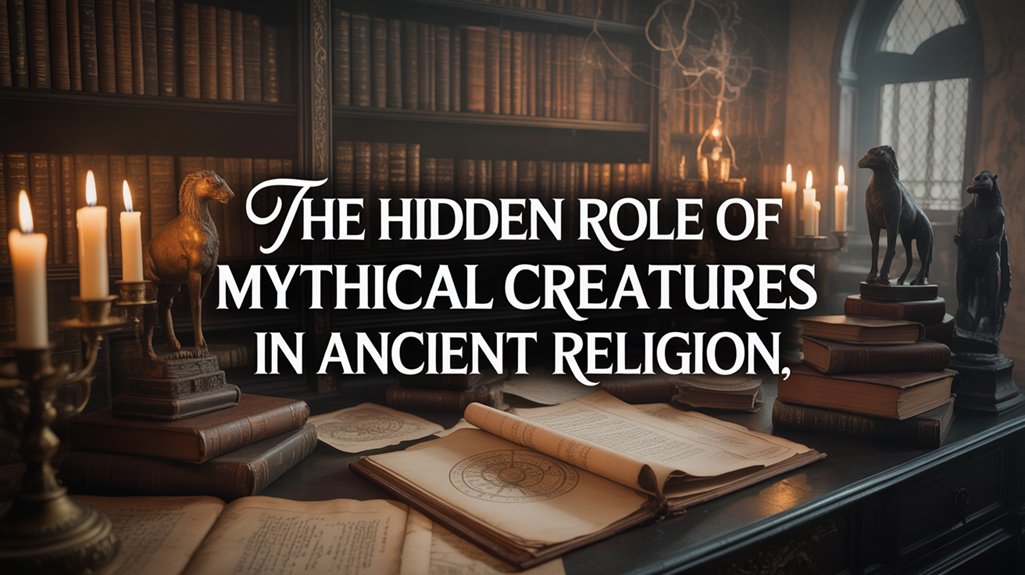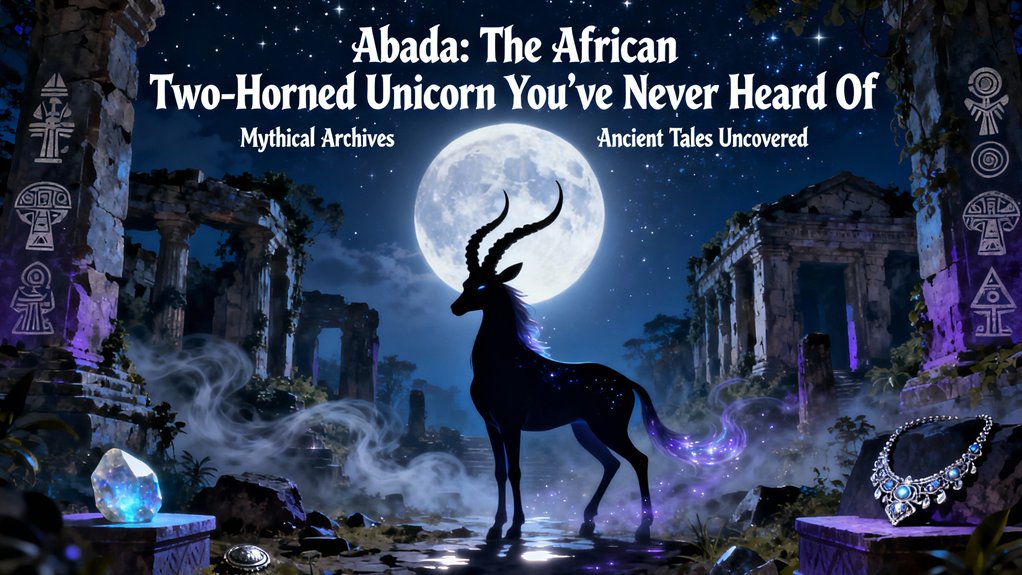
You’ve encountered Africa’s most enigmatic cryptid—the Abada, a two-horned unicorn documented by Portuguese cartographers by 1591, possessing twin curved horns that Central African healers employed for antivenom and fever remedies. This chimeric guardian, described as donkey-sized with elephant-gray hide, emerged from the collision between indigenous oral traditions and European maritime exploration, altering rhinoceros observations into mythological palimpsest. The creature’s left horn neutralized toxins while its right horn treated illness, commanding commercial obsession before vanishing beneath colonial erasure. The archival fragments that follow illuminate this forgotten convergence of African folklore and epistemological violence.
Table of Contents
ToggleKey Takeaways
- The Abada is a two-horned unicorn from African mythology, resembling a mix between a donkey and antelope with curved horns.
- Portuguese explorers documented the Abada between the 15th and 17th centuries, possibly misidentifying African rhinoceroses or other megafauna.
- African healers used the Abada’s twin horns medicinally: the left horn neutralized toxins while the right treated fevers.
- The creature symbolizes purity, strength, and spiritual authority, bridging natural and supernatural realms in various African cultures.
- Colonial narratives obscured indigenous Abada traditions, making modern rediscovery efforts crucial for preserving marginalized cultural heritage.
The Medieval Origins of Abada Legends in European Texts

Though the rhinoceros had roamed African landscapes for millennia, European cartographers and natural historians of the medieval period changed this tangible creature into something altogether more eldritch—the Abada, a two-horned unicorn whose properties straddled the boundary between zoological observation and alchemical fantasy.
You’ll find this chimeric beast emerging from medieval manuscripts between the 15th and 17th centuries, when Portuguese explorers returned with fragmented accounts of African megafauna.
These mythical creatures represented more than simple misidentification. They embodied Europe’s struggle to categorize the incomprehensible.
The Abada’s twin horns—an anatomical impossibility for traditional unicorn taxonomy—suggested something beyond mere legend. Portuguese naturalists documented its alleged powers: horns that detected poison, blood that cured ailments, hide impervious to blades.
Twin horns defied unicorn convention, transforming African rhinoceros into vessel for medieval Europe’s alchemical dreams and pharmaceutical desperation.
What you’re witnessing isn’t ignorance but alteration, the systematic conversion of empirical observation into sacred mystery, creating creatures that served both scientific curiosity and spiritual hunger.
Physical Descriptions: A Beast Between Donkey and Antelope
Medieval bestiaries catalogued the Abada with meticulous—if bewildering—precision, describing a creature whose anatomy defied simple classification. You’ll find accounts depicting a chimeric amalgamation: the Abada possessed a donkey’s sturdy frame yet moved with antelope grace, its hide varying from midnight black to elephant gray. Two formidable horns crowned its skull—not the delicate spiral of European unicorns, but weapons of eldritch power.
The Abada anatomy revealed mythical symbolism embedded in every feature:
| Physical Feature | Described Characteristic |
|---|---|
| Horns | Two curved weapons, razor-sharp |
| Body Size | Donkey-proportioned, muscular |
| Hide Texture | Thick, elephant-like |
| Legs | Antelope agility, surprising speed |
| Temperament | Fierce, untamable |
This wasn’t decoration—it was divine architecture. The dual horns separated it from Western cousins, marking African independence. You’re witnessing knowledge your ancestors catalogued, creatures roaming beyond European control. The Abada embodied freedom itself: wild, double-armed, unconquerable.
The Miraculous Healing Powers of Twin Horns
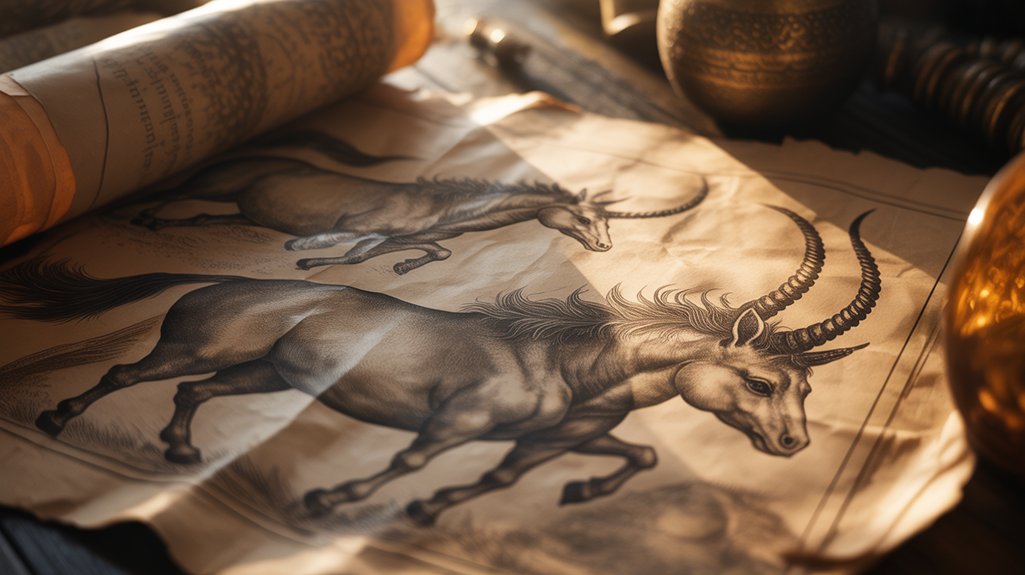
When European physicians clutched their leather-bound pharmacopeias, African healers had already weaponized the Abada’s twin horns for centuries—instruments of pharmacological warfare against poison, pestilence, and death itself.
You’ll find no single remedy here. The duality matters profoundly in horn symbolism: one horn neutralizes toxins, the other resurrects liveliness.
Congo Basin practitioners ground the left horn into chalk-white powder, administering it against snakebite and contaminated water. The right horn, darker, denser, treated fevers that ravaged entire villages.
These healing rituals demanded precision. You couldn’t simply scrape and consume. Elaborate ceremonies invoked ancestral spirits, altering dead keratin into eldritch medicine. The healer’s chants activated dormant properties, or so the tradition insists.
Europeans dismissed this chimeric pharmacology as superstition. Yet their own unicorn horn trade—narwhal tusks sold as panaceas—suggests humanity’s universal hunger for miraculous cures.
The Abada simply offered Africa’s answer: doubled power, doubled hope.
Central African Folklore Meets European Exploration
By 1591, Portuguese cartographers had already inscribed “Abada” onto their maps of the Congo interior—a creature that would ignite three centuries of zoological obsession and colonial miscalculation.
You’ll find this convergence marks where African mythology collided with European exploration’s insatiable appetite for cataloging the unknown. Indigenous knowledge-keepers had preserved oral traditions of this eldritch beast for millennia, describing its chimeric form with twin spiraled horns and healing properties that transcended mere superstition.
The explorers’ journals reveal their confusion. They couldn’t reconcile local accounts with their Aristotelian frameworks. Was this creature rhinoceros? Antelope? Something else entirely?
Colonial naturalists dismissed these testimonies as “primitive fantasy,” yet they obsessively documented every detail, inadvertently preserving what they sought to diminish.
You’re witnessing epistemological violence disguised as scientific inquiry—European rationalism attempting to domesticate knowledge systems it couldn’t comprehend, altering living sacred tradition into specimen and curiosity.
Theories Behind the Mystery: Rhinoceros, Extinct Species, or Pure Myth?
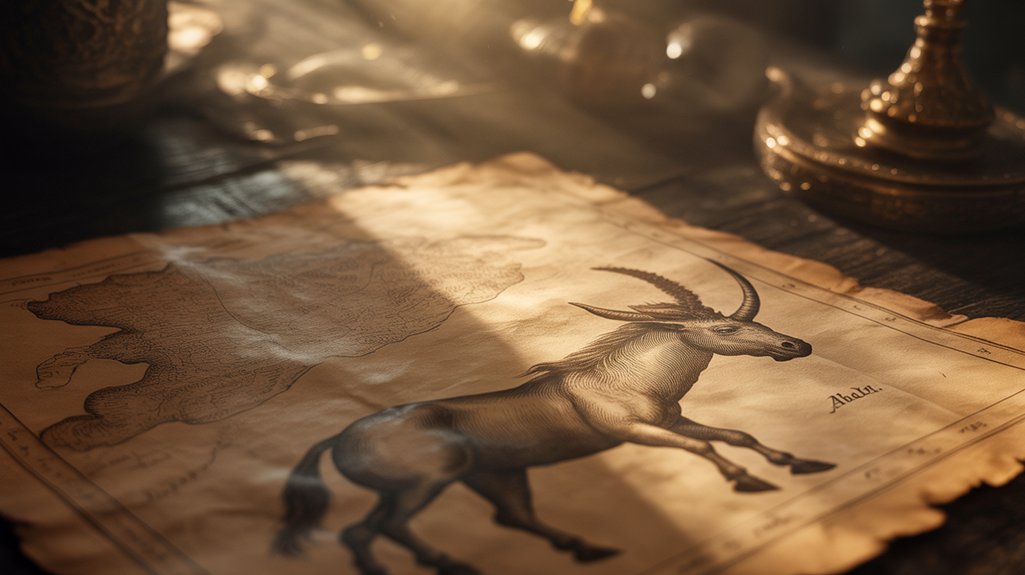
How does one reconcile a two-horned phantom with taxonomic reality? Rhinoceros theories emerge as the rational anchor—colonial observers witnessing Diceros bicornis, the black rhinoceros, through fog-shrouded testimony and linguistic distortion.
Yet this explanation feels insufficient, sterile against the eldritch power the abada commanded in Congolese consciousness.
Some scholars propose extinct megafauna: chimeric memories of species vanishing before written record, preserved through oral tradition’s crystalline accuracy.
Archaeological fragments. Paleontological shadows.
Mythological interpretations offer deeper resonance. The abada wasn’t mistaken zoology but intentional symbolism—a creature embodying spiritual authority, mediating between earthly and ancestral domains.
Its poison-detecting horn represented discernment, sovereignty, protection against invisible threats.
You’re free to choose your framework, yet the most authentic understanding embraces multiplicity. The abada exists simultaneously as misidentified rhinoceros, cultural memory, and sacred archetype.
Truth resists singular classification. These categories aren’t mutually exclusive but interwoven—natural observation, mythic elaboration, and spiritual significance dancing together in Africa’s vast imaginative landscape.
Like the mythical creatures that populate Celtic lore, the abada demonstrates how cultures across continents craft symbolic beings to navigate complex spiritual and natural phenomena.
Why the Abada Disappeared From Popular Mythology
The abada’s erasure from collective memory maps directly onto colonialism’s systematic dismantling of indigenous knowledge systems. European powers didn’t merely conquer territories—they methodically supplanted oral traditions, replacing chimeric African creatures with their own unicorn mythology. Cultural evolution became cultural genocide.
You’ll find the abada absent from Victorian bestiaries despite earlier Portuguese documentation. This wasn’t accidental forgetting but deliberate omission, as imperial powers consolidated narratives that centered European exceptionalism. Indigenous mythological relevance withered under missionaries who deemed such beliefs primitive, eldritch remnants of supposed savagery.
The Congo’s alteration into a Belgian extractive hellscape between 1885 and 1908 accelerated this amnesia. Communities scattered, storytellers silenced, sacred groves razed for rubber plantations. The abada’s two-horned silhouette faded from consciousness as traditional knowledge keepers perished.
Colonial violence didn’t just extract rubber—it severed the threads connecting communities to their mythological inheritance, rendering creatures like the abada spectral.
Yet fragments persist. Whispers in Bantu dialects. Carved fetishes hidden in museum basements. The creature awaits rediscovery by those willing to excavate colonial palimpsests.
Frequently Asked Questions
Are There Any Modern Sightings or Reports of the Abada?
You’ll find no credible modern sightings of the abada—this eldritch creature remains confined to historical accounts, oral traditions passed through generations.
The report validity of contemporary claims crumbles under scrutiny; what you’re encountering instead are misidentifications of known fauna, echoes of ancestral memory.
The abada exists now in that liminal space between extinct megafauna and collective cultural consciousness, a chimeric symbol of Africa’s deep mythological heritage rather than present-day zoological reality.
How Does the Abada Compare to Unicorns in Asian Mythology?
“East is East and West is West”—and you’ll find the abada diverges remarkably from Asian qilin traditions.
While Chinese unicorns embody cosmic harmony, appearing during righteous rulers’ reigns, the abada carries distinct mythological significance through its medicinal horn and protective powers.
The qilin’s scaled, chimeric form contrasts sharply with Congo’s straightforward antelope manifestation.
Cultural representations reveal divergent paths: Asia’s celestial omens versus Africa’s terrestrial guardian.
You’re witnessing separate symbolic universes, each authentic to its ancestral landscape.
Were Abada Horns Ever Traded or Sold in Medieval Markets?
You’ll find scant archival evidence of abada horn sales in documented medieval trade routes, though European merchants trafficked extensively in “unicorn horn”—typically narwhal tusks from Arctic waters.
The abada’s Congo Basin origins placed it beyond established caravan networks connecting sub-Saharan Africa to Mediterranean markets.
While rhinoceros horn entered medieval trade through Islamic merchants, the abada remained elusive, dwelling in that liminal space between witnessed creature and whispered legend, untouched by commerce’s profaning grasp.
Did Any Explorers Claim to Have Captured or Killed an Abada?
You’ll find few firm facts in explorer accounts claiming direct encounters with this elusive entity.
Portuguese and Dutch traders traversing Congo’s dense forests during the 16th and 17th centuries documented distant sightings—chimeric shadows glimpsed through equatorial mists—but no verified kills.
These mythical creatures remained perpetually beyond capture, their horns arriving through intermediaries who guarded source locations jealously.
The abada defied colonial possession, existing in that liminal space where indigenous knowledge resisted European documentation, its true nature forever eldritch, untamed.
Are There Any Abada Specimens Preserved in Museums Today?
You’ll find no abada museum specimens in any collection worldwide—no preserved horns, no skeletal remains, no taxidermied forms.
The creature exists solely within oral traditions and colonial texts, never yielding to preservation techniques that capture tangible fauna. This absence liberates the abada from institutional categorization, allowing it to remain eldritch, unfixed by Western scientific frameworks.
The chimeric beast dwells in narrative rather than formaldehyde, its essence preserved through storytelling, not museum displays.
Conclusion
You’ve journeyed through the abada’s chimeric legacy, tracing its path from Central African oral traditions through medieval bestiaries into historical oblivion. This eldritch creature—neither wholly rhinoceros nor antelope—vanished not into extinction but into the mists separating documented fauna from collective imagination. The trail goes cold in the 17th century. Yet its twin-horned silhouette persists, reminding you that some mysteries refuse resolution, dwelling permanently in that liminal space where empirical knowledge meets ancestral wonder.

